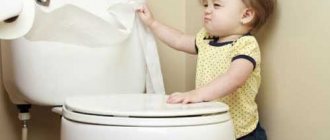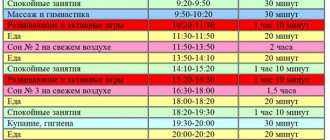Walking is an important element in the development of every child. This is not only a fun activity, but also great benefits for the growth and health of the baby. Walking in the fresh air strengthens and strengthens the immune system, increases appetite and improves sleep. And the sun's rays fill the baby's body with vitamin D, so important for newborns. But during a walk, the child may freeze and become hypothermic. Let's look at how to determine if a child is cold.
Features of hypothermia in children
Hypothermia implies a general decrease in temperature, while the body cools down completely. In this case, the activity of the body decreases and breathing weakens, the speed of blood circulation decreases and muscle movements slow down, and the heart rate drops. And this can happen not only in winter. It all depends on the weather, how long the walk lasts and how the child is dressed.
Hypothermia occurs due to the fact that the baby is not dressed correctly, as well as when staying outside for too long. It is important to prevent hypothermia, otherwise the child may get sick. Moreover, it can be not only a common cold, ARVI or flu, but also a more complex disease. For example, bronchitis, laryngitis, otitis media, rhinitis, pneumonia. But if measures are taken in a timely manner, the child will not get sick.
If adult children can report that they are cold, then this is impossible for a one-year-old baby. Hypothermia is most dangerous for children under one year old who are still walking in a stroller and do not move much. In addition, at this age, thermoregulation processes are still just being formed. Therefore, the younger the baby, the faster he freezes.
To avoid colds and hypothermia, it is important to carefully monitor the condition of the baby. Let's look at how to understand that a child is cold outside. Let's find out what to do to prevent hypothermia. And let's look at how to help the baby if he is already cold.
Signs of cooling
So, you can tell if a baby is hot or cold by looking at the baby’s nose.
If the baby's nose is cold, it means he is frozen. If the nose is too hot, then it is really hot. It is best for the baby to have a warm nose. Then the child feels cozy and comfortable. Hiccups can also be an indicator that the baby is frozen.
If your child hiccups, it is most likely from the cold. You need to immediately take care of a headdress for him. After all, the baby’s head freezes first. It may be really warm in the apartment or on the street, and the child is dressed in an outfit appropriate for the weather, but at the same time his nose is cool and hiccups have begun... In this case, the mother needs to put on a cap or a light hat, let the baby drink some warm water or tea, and the hiccups should stop immediately. And now, your baby is cheerful and happy again!
How to warm up a child?
If the baby is cold, he must first be warmed up in a warm room. There is no need to rub cold areas of the body with your hands, alcohol, cloth, and especially with snow. This will only worsen the condition of the affected tissues.
A child who is frozen outside should be wrapped in a warm blanket and given a few cups of hot sweet tea to drink. While the baby is warming up, parents can tell him an interesting fairy tale or some story that will definitely distract the baby from unpleasant sensations.
If only a hand or foot is frozen, it must be warmed in a warm bath, gradually increasing the temperature of the water from 20 to 40 °C. Gently massage the frozen foot of the baby for 30-40 minutes.
Soaring legs
As soon as you realize that the child is cold, quickly take him home. Warming treatments needed! They have a vasodilating effect, due to which blood circulation accelerates and the body's defenses increase. So hurry up and get your feet wet!
Wash the basin with soda. Pour 1-2 tbsp into it. spoons of dry mustard. Pour water (temperature not lower than 37 °C). When the powder dissolves, ask your son or daughter to put their feet in the bowl. After 2-3 minutes, the baby should take out his legs, and you add some hot water. The total duration of this procedure is no more than 10-15 minutes. After this, to consolidate the effect, you need to put on warm socks for the baby.
Is your child bored of sitting around doing nothing? Funny waterfowl toys will amuse you. Let ducks, fish, dolphins, and large whales also warm their paws, tails, and fins.
Let's do inhalation
Eucalyptus leaves, sage or pine buds (brew 1 tablespoon in 1 glass of boiling water), fir and tea tree essential oils (2-3 drops) are excellent means for steam inhalation.
Pour the necessary raw materials into the inhaler. Sit on a chair and take the child on your lap. Breathe in the healing vapors. By the way, a similar procedure can be carried out even if there is no special device at home. When the baby is sleeping, place a bowl of brewed herbs near the crib. For an older child, prepare a wide cup. However, no matter how you carry out the inhalation, make sure that your baby doesn’t get burned (do not bend close over the steam) or spill boiling water on himself!
During inhalation, together with the baby, adjust the duration of the procedure. How? Math will help! Count out loud to one hundred, and let the baby repeat (if he gets confused, correct him) and run on playing!
Rubbing ourselves
Forward movements of the hands relax muscles, improve blood circulation and tissue nutrition. In addition, they provide excellent warmth and help prevent respiratory diseases.
First, lightly rub the baby's back and chest using a terry mitten. Then apply warming ointment. It is advisable to do all this at night. However, before putting on pajamas, blot off excess oil with a regular napkin. Then there will be no stains on the blouse.
Let the baby treat your favorite doll, a rubber baby doll. Give your little one some baby cream and a massage mitt - let him feel like a doctor.
Drinking tea
Raspberries, viburnum, cranberries, lingonberries are rich in vitamin C. And it is known to perfectly increase the body's defenses. So take out homemade preparations - jam, preserves, berries ground with sugar and start creating.
Place the berries, grated with sugar, into a cup of warm boiled water and stir everything well. Let it sit for a couple of minutes. Then strain through a sieve and don’t forget to add a slice of lemon (or squeeze the juice out of it).
The gifts of summer did not survive until winter? Don't worry! There are ready-made drinks made from the same fruits on sale - use them.
Be sure to read what is written on the label! Moreover, you should be interested not only in the expiration date and composition of the product, but also in who it is intended for.
For babies, it is better to buy special teas from the baby food series. Of course, from a well-known company. There must be a label indicating the age of the child for whom this product is recommended.
For older children, you can brew bags of herbal, fruit, and berry tea intended for adults (usually it is recommended to brew 1 bag with about 500 ml of boiling water).
If you insert a bright, beautiful straw into a glass or cup with a prepared drink, and decorate the edges with snow (moisten the edge of the container and sprinkle with semolina), the baby will drink every last drop. With great pleasure! And the next morning he will wake up healthy!
We give drugs
Sometimes one of the interferon-based drugs (Laferon, Viferon, Laferobion) is prescribed as first aid for hypothermia. It is recommended to be used for both therapeutic and preventive purposes to increase the body’s resistance to various diseases. However, such medications are effective if the disease can be caught at a very early stage.
Herbal immunomodulators (for example, Svitanok, Dzherelo) also help increase a child’s immunity. In emergency cases, experts advise increasing the dose of such herbal remedies (by about 2-3 drops).
Has your child complained of a sore throat? Chlorophyllipt will help cope with this symptom. He will not allow the disease to gain momentum. Please note: this drug is available in the form of tablets, oil and alcohol solutions, and sprays. Your doctor will tell you what is best to use in case of hypothermia.
How to calm a frozen baby?
To soothe a frozen baby, you can give 5-7 drops of valerian or motherwort tincture mixed with half a glass of water. If the baby cannot tolerate pain during the warming process, you can give him a vasodilator, for example, No-shpu.
By the way, parents should always remember that previously frostbitten areas of the baby’s body remain sensitive to frost for a long time, they are easily susceptible to frostbite again, and therefore need special protection from frost, cold and wind!
Source: https://ivona.bigmir.net/deti
How to understand that a child is cold: signs of hypothermia
- The main sign is coldness behind the collar, on the back, on the arm above the wrist and under the hat. To check your baby, place the edge of your hand under your clothes. If the skin is warm and dry, the baby is not cold;
- Sharp paleness of the skin and lips. Paleness of the skin occurs due to slow blood circulation. This indicates that the baby has become hypothermic and is very cold. And if the baby’s cheeks, on the contrary, are rosy, then everything is fine;
- The fingers and backs of the hands become cold and purplish-red in color, go numb and lose sensitivity. When rubbing your palms, your baby will feel a burning sensation and pain. Numbness of the limbs indicates severe freezing;
- The child becomes lethargic, indifferent and apathetic. He stops vigorous activity, loses interest in walking, shrinks and trembles, or moves slowly;
- Children under three years old experience severe and sudden drowsiness. They may cry quietly at first and then fall asleep. In this case, the face of a baby sleeping in a stroller becomes pale, white spots appear on the skin, and the nasolabial part of the face becomes bluish.
A child is not cold if he has cool or even cold hands, cheeks and nose, but at the same time he is cheerful and cheerful, actively jumps, runs and plays. Your baby's skin may be cold on exposed areas of the body due to the cold winter air. But this does not mean that the baby is cold.
How to understand that a baby is cold: what points to pay attention to first
First of all, you need to evaluate two main parameters: the air temperature and the baby’s clothes.
Adults often, out of habit, prefer that the room be warmer. However, this approach has a detrimental effect on the child, depriving him of natural hardening and disrupting the functioning of the thermoregulation system from birth. No one calls for deliberately freezing a baby, but it is better to once again weigh the pros and cons before additionally wrapping the baby. This especially applies to the rule of “wearing one more layer on a child than an adult” under all circumstances.
A small life hack that protects against overheating: if the skin under the diaper is redder and hotter than in other parts of the body (we are not talking about rashes and other skin disorders), then it is likely that systematic overheating is occurring.
What to do if your child is cold
Hypothermia, especially severe and prolonged, reduces immunity, as a result the child can catch a cold and get sick. As soon as you realize that your child is cold during a walk, immediately go into a warm room or return home. If this is not a newborn, but an older baby, on the way home, make the baby actively move, wave his arms, run and jump.
If the child is cold and he is still sitting in the stroller, but already knows how to walk, bend his legs, play palms and rub his hands together. Blood circulation will increase, the baby's legs and arms will warm up. With a newborn or an infant up to six months old, immediately go to the nearest warm room, for example, a store. Wait until the skin turns pink and it becomes warm under the hat and behind the collar. This indicates that the little one has warmed up a little. After that, go home immediately.
When you arrive home, immediately remove your outer clothing and shoes. Dress the baby in dry and warm clothes, wrap him in a blanket and give him a warm drink or feed him warm broth. If your child gets warm and sweaty, change wet clothes immediately, otherwise he may become hypothermic again!
Warm tea or drinks with lemon, rose hips, honey and ginger, cranberry or lingonberry juice or jelly have an effective warming effect. At the same time, the drink should not be scalding and hot! Such drinks will not only warm the baby, but also strengthen the immune system and protect against colds. How to prepare healing jelly for babies, see here.
Optimal temperature for a child's room
A newborn quickly freezes in the hospital when the environment changes from warm and humid to dry and much cooler. It needs an air temperature of 22-26ºC. Hypothermia is a serious problem in infants, especially premature infants, in the first hours and days of life. That's why it's always hot in postpartum wards.
Hammock for bathing newborns - how to choose
Perhaps this is where young mothers get the idea that the baby needs to be dressed warmly, turn on additional heating radiators, etc., especially if he was born in late autumn or winter. However, it is necessary to correctly understand the needs of the baby, guided by common sense and moderation.
Important! The best air temperature for a room where a small child lives is 20-22ºC. At night, while the baby is sleeping, the optimal value is 18-19ºC.
In addition, you should regularly ventilate the room where the newborn’s bed is located, while removing the crumbs from it.
Airing the room
What to do to keep your child from freezing
To understand what to do to keep the baby from freezing and to make the baby comfortable while walking, you need to determine the causes of hypothermia. First of all, these are clothes and shoes that are not suitable for the weather. They may be too light or, conversely, too hot. Things should not be tight or constricting.
The cause of hypothermia is damp clothing, socks and tights, and wet shoes. Therefore, regularly check things for dryness. If the baby is wet, if the child’s feet are cold, immediately go home to change clothes. In addition, a child may freeze if he moves little during a walk.
Do not give your baby cold drinks or food while walking outside! Do not bottle feed your baby outside during the cold season! In severe frost, wind or humidity, do not walk for too long. In this weather, 30 minutes is enough.
Hypothermia occurs not due to frost and low temperature, but, first of all, due to strong cold wind and/or high humidity outside. In any case, it is important to dress the child correctly and organize the walk correctly. Let's take a closer look at how to dress your baby in winter. And we will learn the rules of walking for babies.
Newborn clothes
When a mother knows how to understand that a small child is cold, or, on the contrary, he is hot, she must learn how to properly dress the baby.
A few rules for dressing babies at home and on walks:
- When traveling in a car, it is best to undress the child, leaving him in a warm blouse, perhaps covering him with a blanket. This is also required by car seat manufacturers who do not guarantee the safety of a child in warm winter clothes;
Important! Babies do not tolerate sudden changes in temperature, both in summer and winter. Therefore, it is necessary to pay close attention to air conditioning systems. When transporting a baby in a car, it is necessary to reduce the intensity of heating or cooling of the air.
Baby in a car seat
- When going for a walk with a child, you need to follow the old rule: put on one more layer of clothing than an adult needs. Several layers of clothing are needed so that you can easily put on or take off one of them if necessary. If the baby falls asleep in the stroller, you should cover him with a blanket, or on hot days with a diaper.
Important! A child who is hot becomes irritable and loses the desire to play. Small children react by crying.
- Children dressed too warmly can quickly freeze because, firstly, they are sweaty, and, secondly, a thick layer of clothing interferes with movements;
- At home, at a temperature of 20-22ºC, the baby should be dressed in two layers of thin cotton, for example, chintz and flannel. When falling asleep, cover with a blanket of medium thickness;
- When the baby begins to walk, you should focus on the clothes of an adult. If the adult is comfortable in a short-sleeve T-shirt, there is no need to put two shirts on the baby;
- Many parents believe that it is obligatory to put a hat on their baby’s head, even at home. In fact, at home it is recommended to wear a baby cap only for 15-30 minutes after bathing in the first months of life. On hot sunny days in an open stroller, it is necessary to protect the baby's head with a panama hat or a thin hat. Pediatricians advise children under one year to wear warm hats when the air temperature is less than 12ºC.
Baby in a hat
Newborns still have difficulty regulating their body temperature; they cannot tell their mothers that they are hot or cold. Therefore, parents must understand how to determine whether a child is overheated or hypothermic and take appropriate measures.
Rules for walking with a baby
- It is not recommended to walk with an infant in severe frost, strong wind or high humidity, extreme heat, or a snowstorm;
- You cannot walk with your baby if he is sick. However, during the recovery period, when the temperature has already subsided and the pain and weakness have passed, short walks in the fresh air are recommended. This will speed up recovery, restore the body faster and strengthen the immune system after illness;
- The first walk with a newborn can be done within a week after the baby is born. However, it is important to consider the weather. If it is too cold or hot outside, it is better to postpone your walk;
- At first, in winter you can walk for 10-20 minutes, in summer - no longer than half an hour. Gradually increase the duration of your walks by five to ten minutes;
- When the baby has already gotten used to fresh air and new conditions, in comfortable weather it is recommended to go for a walk two to three times a day. In this case, the walk time can be 1.5-2 hours;
- Dress your child according to the weather. Avoid wearing tight or too hot clothing. At the same time, it should not be too loose. The younger the child, the fewer free areas of the body without clothing should remain.
The benefits of daily walks for children's bodies
A walk is an essential part of an infant’s daily routine. Regular stay in the fresh air greatly contributes to the full development of the baby and improves overall well-being. After receiving a portion of oxygen, the baby will definitely please his parents with an excellent appetite, restful sleep and good mood.
While being outside, you must constantly ensure that the baby does not freeze, and that a walk does not lead to hypothermia and illness.
How to dress a child for a walk in the cold season
In the first two months of a baby’s life, it is important that a minimum of areas of the body remain free from clothing; it is important to securely cover the back and abdomen. Therefore, a solid sleepsuit or overalls would be a suitable solution. It is recommended to dress your child in several layers. This will ensure a comfortable temperature, and at the same time, if necessary, you can easily remove the layer if the child becomes hot, or you go to a store or clinic.
Clothing should be comfortable and made from hypoallergenic fabrics. It should not constrain or limit movement, get wet or be too loose. Today, manufacturers offer a lot of different options for winter clothing for young children. This is a comfortable and light winter overall, jacket and pants, mittens, hats and other items that are warm and comfortable to move around in.
Modern winter clothing includes several thin layers of special breathable and waterproof fabrics with light and warm insulation. Many things can be combined and modified due to removable parts, which is very practical and rational. The most popular companies are Reima, Kerry, Lassie, Lenne and others.
Choose clothes according to the weather, taking into account not only the temperature, but also the wind speed and humidity level. Pay attention to whether it is sunny outside or whether it is snowing or raining. For children under one year old who move little and sit in a stroller while walking, choose warm envelopes.
Do not dress your baby too warmly and do not wrap him in dozens of layers.
Otherwise, this will lead to overheating, as a result of which the child will definitely get sick. Signs of overheating include thirst, a hot back and neck, and too warm hands and face. For more information on how to properly dress a child in winter, read the link. Subscribe to our VKontakte group
What to do to prevent hypothermia outdoors
The main condition for a child’s comfortable stay in the fresh air during the winter season is the correct choice of clothing. When dressing your newborn baby for a walk, you need to consider the following:
- insulate the baby according to the weather, in several layers;
- do not leave areas where clothing does not fit tightly;
- cover the tummy and back well;
- Don't forget about warm mittens.
The best option for outerwear at an early age would be a one-piece jumpsuit or slip made of hypoallergenic fabric. A one-month-old baby who is constantly in a stroller during walks should be in a warm fur envelope.
While outside, you should not give your child anything to drink from a bottle. If the little one has already started walking, the mother should regularly check the dryness of his shoes and mittens.
The duration of exercise (walk) in frosty weather should not exceed 30 minutes. You should avoid walking if the outside temperature is below -15 degrees, there is wind and snowstorm.
If you notice signs of hypothermia in an infant, you should stop walking and immediately return home or go into the nearest building to warm up. With babies who can already walk, you can play by bending and unbending their arms and legs. This will help improve blood circulation, stop stiffening and warm up a little.
Arriving home, you must immediately remove the baby’s outer clothing and change into clean, dry clothes. After this, you need to rub his arms and legs, and then provide him with a warm drink.
It is equally harmful to dress a baby too warmly. Overheating is dangerous due to the increased risk of getting sick from the slightest breath of wind.
What to do to keep your baby from freezing indoors
Keeping your baby in the house requires maintaining the correct temperature. Traditionally, pediatricians recommend providing a heat level in the children's room within 18–22 degrees.
If it turns out that the baby is freezing at night while sleeping, you should not try to solve the problem by turning on the heater. Overheating a baby does not contribute to normal thermoregulation and prevents the body from “learning” to retain heat. And overdried air in the room interferes with thermoregulation through the respiratory tract and dries out their mucous membranes.
If the temperature in the room is normal, but the baby gets cold at night, you should dress him warmer before going to bed or cover him with a thin blanket. At temperatures of 20–25 degrees, it is recommended to sleep in knitted underwear, covered with a thin sheet. At the same time, do not forget to wear socks on your feet. If the lower limbs do not get cold, the baby’s sleep will become much stronger and more peaceful.
Important rule: The younger the child, the faster he gets hypothermic
Remember one important rule. The younger the child, the more susceptible he is to the negative effects of low temperatures. And, as a result, faster frostbite.
If you discover at the wrong time that your baby is cold, his body temperature may drop sharply. And he will experience discomfort after the walk.
Video “How to dress a child in winter” (Komarovsky)
- Author: Polina
Hello. My name is Polina. Having once heard the truth that a pediatrician is the main doctor for any family with small children, I realized that I had something to strive for. Rate this article:
- 5
- 4
- 3
- 2
- 1
(4 votes, average: 4 out of 5)
Share with your friends!
What to do if a child is afraid of doctors?
What to do if your baby is choking?
What is hypothermia?
Hypothermia is freezing of the child's entire body. It occurs when the body temperature drops below thirty-four degrees. Adults often confuse hypothermia and frostbite.
The latter is significantly different. As part of normal frostbite, only a specific area of the child's body freezes. For example, ears, fingers or hands. The rest of the body has a traditional temperature.
When a child experiences hypothermia, he freezes completely.











